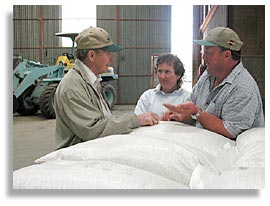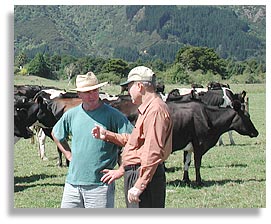|
Opposing Genetic Engineering in New Zealand
(and around the world) by Bill Christison
In February 2001, Bill Christison travelled from the U.S. to New Zealand to present testimony to, and answer questions of, New Zealand's Royal Commission on Genetic Modification. Before and after the hearing, he travelled around New Zealand visiting farmers and community leaders listening to their views, recounting his negative experience with genetically modified crops in the U.S., and discussing alternatives. The following are excerpts from his official testimony submitted in advance. Bill Christison is president of the U.S. National Family Farm Coalition as well as president of the Missouri Rural Crisis Center. He spoke as part of a team of experts from around the world assembled by Greenpeace New Zealand. Greenpeace made the case that the Royal Commission should at the conclusion of its year-long hearings recommend to the New Zealand government that they enact laws to make New Zealand GE Free. Currently there are no commercial GE crops in New Zealand. See other interviews here.
President, National Family Farm Coalition and Missouri Rural Crisis Center Bill Christison is a fourth-generation family farmer from Chillicothe, Missouri. Bill and his wife, Dixie, operate a 2,000 acre farm on which they produce soybeans, corn, wheat, hay and cattle. The Missouri Rural Crisis Center (MRCC) is a grassroots farm organization with over 4,000 member families. MRCC is a NFFC member group. Bill has served on numerous boards and appointed positions. He has also worked on local, state, and national political campaigns. Since the 1980s, Bill has worked on the need to change federal farm programs due to its failure to work for family farmers. This included work to change credit legislation to enable family farmers to refinance their debts and the ongoing need to change the commodity provisions of the farm bill to enable farmers to earn a fair price for what they produce. NFFC has developed a new farm bill legislative proposal. Bill’s leadership has resulted in active US family farmer involvement on the genetic engineering issues. NFFC led the recent effort in the preparation and release of a Farmer Declaration on Genetic Engineering. Bill is one of the leaders from NFFC active in the filing of the massive international anti-trust lawsuit against Monsanto which was filed December 14, 1999. Bill has represented NFFC at international meetings in Europe and in the Via Campesina. He was a member of the U.S. delegation to the United Nations CSD-8 meeting in New York in April 2000. Through MRCC, Bill has been active in confronting and stopping the advance of corporate factory hog farming in his state. MRCC has developed the Patchwork Family Farms Project, an innovative direct marketing program ensuring family hog farmers a fair price for their hogs and increasing access to quality hog products for low-income consumers in Missouri. Bill has worked and supported check-off referendums on both pork and beef.
The testimony which I will present will be on behalf of the family farmers around the world and of course the consumers of the products they produce. I will be presenting testimony about
In addition, I would like to present testimony about genetic engineering and globalization. The latest disaster is the contamination of the food chain by the unapproved Bt corn, Starlink. Litigation, concentration, mergers, bad agriculture and trade policy are also points I would like to pursue in my testimony. I would also like to address issues around our American federal agencies, the Environmental Protection Agency, and the Food and Drug Administration and land grant university systems. I would like to speak about alternative systems and programs and international cooperation on issues such as organic and reduced chemical applications, shared international food security resources and supply management. The ecological problems seen from a farmers point of view 1) In the field, farmers near GMO fields have been affected by the ability of GMO crops to withstand new means of herbicide application. With "over-the-top" spraying of chemicals, drift into neighbouring fields becomes more likely, with resulting damage to nearby crops from broad-spectrum herbicides. Greater use of herbicides can also mean more chemicals in water, which can affect rural communities and wildlife. 2) Lab studies have also shown problems that may be occurring in the field, but which are not being monitored. For example, researchers at New York University have found that Bt crops can lead to a build up of Bt in soils, and have warned that this could effect soil insects and microorganisms that farmers depend on for healthy soil. 3) The most publicized lab study on GMO corn that showed a potential harm to monarch butterflies has recently been confirmed by a two-year study that used field and lab work to assess the potential for GMO corn pollen to impact monarchs. This Iowa State research showed that 6 pollen from GMO corn does fall on milkweed plants in cornfields and confirmed the harmful effect of the pollen on monarch larvae. Also, recent field evidence from a group of University researchers showed that milkweed plants grow within and alongside corn fields, monarchs are found on the plants within the fields as much or more than on plants outside the fields, and monarchs peak migration through the corn belt coincides with the period of pollen shed from corn. The issues of cross-contamination 4) Farmers in the U.S. have already have had non-GMO crops contaminated by nearby GMO fields. Currently farmers have no recourse in such situations, since there is no legal protection from this bio-pollution. Farmers who lose premiums for their non-GMO or organic crop have nowhere to turn. Biotech industry spokespeople have suggested that farmers who are concerned about such contamination should take part of their land out of production as "buffer zones." Obviously farmers who are doing nothing different than before feel that they should not now be burdened by the industry's failure to control its technology. 5) Cross-contamination is not merely a potential threat, but one that has already resulted in losses to farmers and food producers. Terra Prima, Inc., a Wisconsin company that makes organic corn chips, had its product pulled from the shelves when it was discovered that GMOs had contaminated the corn supply. The company lost over $150,000 in product recalls and testing costs, and the farmer could face the loss of his organic certification. 6) Seed contamination is also an issue, with biotech companies showing a casual disregard for seed purity and separation of GMO and non-GMO seed. This has led to farmers being forced to tear up fields in Europe, when non-GMO seed was found, after planting, to have been contaminated with GMO seed. Greek farmers lost 9,000 acres of cotton because the seed was contaminated with an unapproved GMO variety.
7) Farmers in the U.S. have seen advertising for GMO crops that claims to reduce costs and increase yields. But the reality isn't always this way. [By producing my own seed, my per acre cost of planting soybeans on my own farm is $6.51 per acre. If I bought the same number of pounds of Round-up Ready (RR) seed, my per acre cost would be $42.00 per acre]. 8) Yields of GMOs are no better and may be worse than comparable conventional varieties. In fact, a two-year University of Nebraska study recently showed that RR soybeans have a genetic yield drag, compared to similar conventional soy. The researchers say that the lower yields are essentially a side-effect of the genetic engineering process. Other University studies and field data from Farm Journal show that RR soy farmers see lower yields and lower economic returns than farmers who use conventional seed. 9) Pesticide use in the U.S. has not gone down in the five years that GMOs have been planted widely. Most of the GMO crops in the U.S. (about 70% of the total acreage) are varieties that require the use of herbicides. The insect resistant crops (which make up most of the remaining 30%) are supposed to save chemical use, but most corn growers do not spray for corn borers anyway. In what way farmers are being harmed 10) U.S. corn and soy exports to Europe are down by almost $1 billion combined, and according to USDA this is due to European rejection of GMOs. Europe is:
11) Just a few measures of the impact of GMOs on the European market are:
12) Japan is also buying less from our farmers, and now that it has been reported that the unapproved StarLink corn was found in Japanese consumer products, that rejection can only intensify. American farmers are very concerned that Brazil and other competitors will capture these customers if our grain is no longer seen as acceptable. 13) Major grain buyers have entered the non-GMO market. Cargill has launched Innovasure, a new venture dedicated to supplying food companies with non-GMO corn ingredients. ConAgra has registered the internet domain names "no-GMO.com" and "Bt-Free.net." ADM and A.E. Staley have both been paying farmers a premium for non-GMO crops for the last year. 14) In October, British supermarket chain Iceland announced that it will ban GMOs from feed used to raise its own-brand meat products. The BBC reports that the other major British supermarket chains - Sainsbury, Waitrose, Marks & Spencer's and Asda - will follow suit and ban biotech feed too. 15) The question farmers need to ask about genetic engineering is who this technology will benefit. Corporations developing the technology, and their investors, will likely benefit. The question that farmers must ask is whether or not the technology will benefit farmers. 16) Farmers in the U.S. are increasingly seeing their way of life threatened by the corporate control of our industry. Genetic engineering increases the farmers’ dependence on biotech companies that control seeds and other inputs. 17) Farmers are taught that they need high yields to be profitable in this economy of low crop prices. While we fight for a fair price, it is not just price and yield but the share of the agricultural economy that determines farmers’ profit. From 1910 to 1990, the farmers’ share of the agricultural economy dropped from 41% to 9%. During this same period, the technologies promoted to farmers have helped bring about this shift from the farm sector to the input sector. 18) Genetic engineering continues and entrenches this shift, as seed contracts make farmers little more than contract labourers working at the beck and call of biotech companies. Mergers and joint ventures among input and marketing sectors also increases this corporate control of farmers. According to University of Missouri economist William Heffernan, just four food company clusters will soon control most of the nation’s food supply.
19) Genetic Engineering has brought with it risk and liabilities which will take years to sort out. Genetic engineering corporations, along with farmers and food processors, have opened themselves up to potential financial ruin because of the liabilities of genetically engineered organisms. I have not heard of a single insurance company that has been willing to cover genetic liability with insurance. It is a certainty all risk and liability should lie at the feet of genetic engineering corporations. It is a shame that farmers of the world unknowingly are assuming risk of all sorts by planting genetically engineered crops. I understand Monsanto alone has more than 200 suits pending. The situation with Starlink corn is certain to bring many more filings. 20) Biotech companies in the U.S. have been aggressive in tracking and monitoring farmers for so-called "seed piracy." They have placed radio and print ads to urge farmers to spy on their neighbours, going as far as offering bounties for suspected seed savers. They have hired private detectives to trespass on farmers' fields in order to sample a crop's genetics. In at least one instance, detectives hired by a biotech company posed as buyers in an attempt to entrap a seed dealer into selling "pirated" seed. The use of patents and licensing laws: 21) Farmers who have saved seed for generations must now sign gene-licensing agreements, which only allow use of seed for one season. For the first time ever, a farmer does not own the seed s/he sows to produce his/her crop. If farmers become dependent on biotech companies each year for seed, they lose their independence and ability to use their judgment and intelligence to create improved varieties at the farm level. 22) Many farmers are seed savers. The fact is, I have always used saved seeds to plant the majority of my soybean crop. The reasons are simple. I plant conventional seeds and the costs of those seed are less than 20% of the costs of genetically engineered seed. If I chose to plant genetically engineered seed, research has shown I would need to expect 5 to 10% less yield. Instead of using 12 to 14 oz of chemicals, I would probably need 75 oz of chemicals, and certainly I could expect no premium on GE soybeans. And, in a larger sense, I could expect future prices to decline because neither the food processors nor the people of the world want genetically engineered products. The impact of transnational corporation controls over seeds and agrochemicals, on farmers in the U.S. The decline in non-GE seed availability: 23) Many farmers have seen a decline in the availability of seed varieties that are not genetically engineered. The biotech industry's purchases of most of the largest U.S. (and world) seed companies in the past few years has meant a diminishing degree of choices for farmers who wish to avoid planting GMOs. 24) The incentive for farmers to use fewer herbicides has also declined, since biotech companies now sell their chemicals cheaply and as a package with their biotech seed. A study funded by the biotech industry admitted that herbicide use on soybeans has increased in the U.S. since GMO soy has become half of our total acreage. This increase is for both overall pounds of chemicals used and pounds used per acre. 25) It is sometimes stated that strict U.S. regulations on GMOs insure that farmers, consumers and the environment are protected. Three agencies, the Food and Drug Administration (FDA), the Environmental Protection Agency (EPA), and the U.S. Department of Agriculture (USDA) are said to be looking out for any problems regarding GMO crops. 26) A U.S. federal judge recently found that FDA currently has no binding regulations on GMO food. The agency has acknowledged that “FDA has not found it necessary to conduct comprehensive scientific reviews of foods derived from bioengineered plants based on the attributes of these products, but…expects developers to consult with the agency on safety and regulatory questions.” 1 27) Direct oversight by EPA of GMO crops only applies to the insect resistant Bt plant pesticides. The agency’s 1995 proposed policy showed that EPA intended from the outset to exempt the majority of Bt plants from insecticide or food regulation. The policy stated, “[EPA] believes that most plant pesticides would not require regulation under [the Federal Insecticide, Fungicide and Rodenticide Act] …Similarly, under the [Food, Drug and Cosmetic Act], the agency believes that most plant pesticides should be exempt from the requirement of a tolerance.” 2
29) The situation with StarLink corn shows the failure of the U.S. government’s regulatory approach. The biotech company was only allowed to sell the seed with the understanding that it has systems in place to insure that the seed was kept out of the human food supply. Tests that showed food contamination were not conducted by FDA or any other federal agency, but by environmental groups who are concerned about GMOs. 30) The biotech company, Aventis, initially responded to the test by claiming that its stewardship program was sound and insuring that the StarLink was only used for proper channels. Later, when the contamination was confirmed, EPA officials admitted that an audit of Aventis in 1999 found that the biotech company could not account for the end use of all the StarLink seed sold that year. USDA officials now say that there are 9.6 million bushels of StarLink still at the farm from this year’s seed, with 1.2 million bushels unaccounted for. That missing crop is likely to contaminate 25 million bushels of corn, according to USDA estimates. 31) Farmers are very concerned that they will be left holding the bag from this StarLink crisis. Recently, our Farmer-to-Farmer campaign has warned farmers against signing retroactive growers’ agreements with Aventis. Contrary to Aventis’ agreement with the government, seed companies sold StarLink without uniformly informing farmers that the crop was to be segregated from conventional corn in order that it not commingle with corn used for human food products. Instead of farmers now being asked to sign papers they should have seen last spring, we believe that Aventis should be held liable for contamination of conventional corn fields. However, the U.S. has no regulatory structure for insuring that farmers are protected from this bio-pollution. 1 US Food and Drug Administration, Center for Food Safety and Applied Nutrition, “Guidance for Industry: Use of Antibiotic Resistance Marker Genes in Transgenic Plants,” appendix two, September 4, 1998. 2 EPA policy quoted in Michael Hansen, “A Regulatory Patchwork – With Big Holes,” May/June 1999, The Environmental Forum, p. 51. Also see:
|
|||||||||||||||||||||||||||||||||||||||||||||||||||||||||||||||||||||||||||
| Published in In Motion Magazine February 25, 2001. |
|||||||||||||||||||||||||||||||||||||||||||||||||||||||||||||||||||||||||||
If you have any thoughts on this or would like to contribute to an ongoing discussion in the  What is New? || Affirmative Action || Art Changes || Autonomy: Chiapas - California || Community Images || Education Rights || E-mail, Opinions and Discussion || En español || Essays from Ireland || Global Eyes || Healthcare || Human Rights/Civil Rights || Piri Thomas || Photo of the Week || QA: Interviews || Region || Rural America || Search || Donate || To be notified of new articles || Survey || In Motion Magazine's Store || In Motion Magazine Staff || In Unity Book of Photos || Links Around The World || OneWorld / US || NPC Productions Copyright © 1995-2011 NPC Productions as a compilation. All Rights Reserved. |
|||||||||||||||||||||||||||||||||||||||||||||||||||||||||||||||||||||||||||






